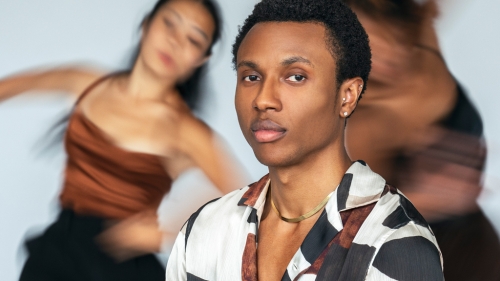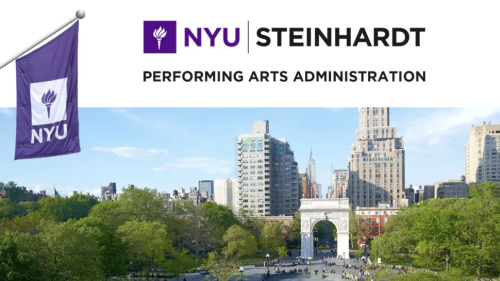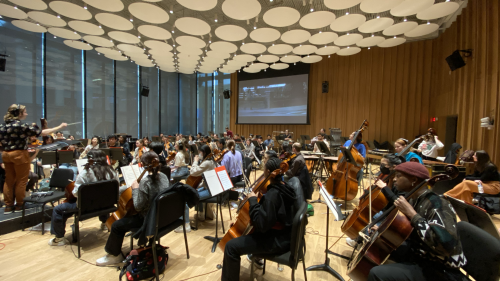
Derick McKoy, Jr. ('23), the Founding Artistic Director and CEO of McKoy Dance Project || MDP, embodies what it means to establish a career in the arts on his own terms. As a dancer, choreographer, artistic director, and CEO, his journey is a testament to resilience, adaptability, and an unwavering dedication to his craft. From an epiphany on his 25th birthday that led him to graduate school at NYU to founding his own dance company in response to a social awakening, Derick’s story is one of bold decisions and fearless leadership.
Current Performing Arts Administration graduate student Payton Rhyan ('25) met with Derick to interview him about how he embraces authenticity and curates his life in the arts. This interview has been edited for length and clarity.
From an Epiphany to NYU: A Leap of Faith
Q: What was your journey to NYU?
Derick: It’s kind of funny—it was on my 25th birthday when I had an epiphany. I just said, “I’m going to grad school.” My path had already been winding—I started dancing late, initially pursuing acting and computer science. A morning announcement about my middle school dance team changed everything. I moved to New York to attend the Ailey/Fordham BFA program (with only three years of official dance training), and balancing full-time work in the Development Department while navigating the audition circuit. After graduating, I landed my first company job with Nimbus Dance, where I danced and built their development infrastructure.
By then, I had already started my company, spurred by the murder of George Floyd and the stillness of the COVID-19 pandemic. It was a moment of racial and identity awakening as a Black, queer artist. For the first time, I took a hard look at the work I was creating, the stories I was telling, and where I wanted my career to go. I had always envisioned becoming an artistic director in my forties, but in that stillness, I fast-tracked that dream.
I created These Stars or Something Heavy, a docu-dance film interrogating the irony of “liberty and justice for all.” That project led to a residency and the premiere of Hush! in 2021. But I felt another transition coming. That birthday revelation about grad school led me back to Ailey, where I worked full-time while completing my master’s at NYU in the evenings. It was a juggling act, but it sharpened both my artistic and administrative skills. Then, as I neared graduation, an unexpected door opened—I was offered a position with Dallas Black Dance Theatre. I made the leap, finished my final semester virtually, and now, two years later, I've gone deeper into education, choreography, and building McKoy Dance Project.
Balancing Artistry and Arts Administration
Q: Arts administration wasn’t necessarily your intended path, yet you’ve embraced both leadership and creative roles. How do you navigate these identities?
Derick: Honestly, people ask me this all the time, and my answer is: I just do it. I’m a bit of a workaholic, which isn’t always a good thing. My phone gives me anxiety because there’s always something—work, the company, teaching. There’s always something I have to do.
I suppose I fell into administration accidentally—but not really. I always knew I wanted to be a director, and when I was in my BFA program, I took a job in development. Turns out, I was good at it, so they kept calling me back. The funny thing is, I don’t actually like fundraising, but that’s my expertise. Now, after NYU, I handle finance for my company. Development is exhausting—funding for the arts keeps dwindling, and priorities are shifting toward education and healthcare. Yet, arts administrators play a crucial role in keeping creative institutions thriving, ensuring that artists and organizations can continue their work despite these challenges. Arts administration aligns with my personality. Managing people, creating efficient systems, and cultivating a healthy work environment—these things matter. Arts administration is the spine of the system. If some of the gears are missing or rusted, the whole thing starts to fail.
Mentorship and the Power of Guidance
Q: You’ve spoken about a mentor who has been pivotal in your journey. How did you build and sustain that relationship?
Derick: I started dancing late—I had raw talent but no technique. A security guard saw something in me and introduced me to my mentor. Within three months, I had my first major injury, dislocating my right knee. I was on the floor crying, and she leaned in and said, “This is the moment—you either leave this behind, or you stick with it forever.” A year later, I dislocated the other knee, and I am still stuck with it. She was right. Every dancer has that fork in the road.
She always told me, “Wherever you go, take stock of what’s good, what’s bad, and what you’ll do when it’s your turn to lead.” That’s how the arts evolve. We inherit traditions, but we also create change. Some companies resist that change, but if you see it, you have to make it. You don’t have to wait for permission—start your own, be the choreographer, pass down the lineage. Dance isn’t just learned from books; it’s passed down verbally, physically, emotionally.
Even now, she’s still in my life. We have long phone calls about everything—dance, the company, politics, life. That’s why I call her my dance mom—because it was never just about dance.
Building Inclusive Spaces in Dance
Q: How have your experiences shaped your approach to diversity in your company?
Derick.: Before COVID, the works I was making felt performative. My best friend, who was also my associate artistic director, pointed out that I mostly worked with white dancers—and I hadn’t even realized it. At Ailey, despite being surrounded by Black dancers, my work still leaned toward a traditional ballet archetype, which historically centers white bodies. That was an unconscious bias I had to confront.
Now, I intentionally center Black dancers. My company is majority Black, with a strong Asian presence and one white dancer. But beyond race, our mission is to empower marginalized voices. It’s about representation—creating a space where people feel seen, amplified, and celebrated.
Advice for Aspiring Artists
Q: For NYU students aspiring to follow in your footsteps, what advice would you give?
Derick: Lean into your skills. I used to hate it when people said, “Know your strengths.” As a dancer, I wanted someone to tell me exactly what to do. But once you figure it out, everything becomes easier—what to pursue, what to say no to, what direction to take.
It’s not just about what you’re good at—it’s also about what you want to learn. If you’re interested in something, go after it. Don’t let anyone stop you—not even yourself. The key is clarity. Don’t chase something just because it looks cool or pays well. Find your niche. Once you do, you can expand, grow, and excel because you understand exactly who you are and where you should be.
Being an expert in your art doesn’t make you an expert in leadership. I’ve put in the work, and it is hard. There are days I want to quit and days I feel defeated. But I stick with it because of the people—the dancers, the audience, the ones I mentor. That’s what brings me back. And that’s what makes me proud.
Derick's journey is a lesson in taking control of one's narrative, creating space where it didn’t exist, and leading with authenticity. His time at NYU was one step in his journey, but his vision, courage, and commitment to change are what continue to shape his career.


